2014 Hyundai Santa Fe brake fluid
[x] Cancel search: brake fluidPage 538 of 711

589
Driving your vehicle
Change to "winter weight" oil
if necessary
In some climates it is recommended
that a lower viscosity "winter weight"
oil be used during cold weather. See
section 8 for recommendations. If
you aren't sure what weight oil you
should use, we recommend that you
consult an authorized HYUNDAI
dealer.
Check spark plugs and igni-
tion system
Inspect your spark plugs as
described in section 7 and replace
them if necessary. Also check all
ignition wiring and components to be
sure they are not cracked, worn or
damaged in any way.
To keep locks from freezing
To keep the locks from freezing,
squirt an approved de-icer fluid or
glycerine into the key opening. If a
lock is covered with ice, squirt it with
an approved de-icing fluid to remove
the ice. If the lock is frozen internally,
you may be able to thaw it out by
using a heated key. Handle the heat-
ed key with care to avoid injury.
Use approved window washer
anti-freeze in system
To keep the water in the window
washer system from freezing, add an
approved window washer anti-freeze
solution in accordance with instruc-
tions on the container. Window wash-
er anti-freeze is available from an
authorized HYUNDAI dealer and
most auto parts outlets. Do not use
engine coolant or other types of anti-
freeze as these may damage the
paint finish.
Don't let your parking brake
freeze
Under some conditions your parking
brake can freeze in the engaged
position. This is most likely to hap-
pen when there is an accumulation
of snow or ice around or near the
rear brakes or if the brakes are wet.
If there is a risk the parking brake
may freeze, apply it only temporarily
while you put the shift lever in P
(automatic transaxle) or in first or
reverse gear (manual transaxle) and
block the rear wheels so the vehicle
cannot roll. Then release the parking
brake.
Don't let ice and snow accu-
mulate underneath
Under some conditions, snow and
ice can build up under the fenders
and interfere with the steering. When
driving in severe winter conditions
where this may happen, you should
periodically check underneath the
vehicle to be sure the movement of
the front wheels and the steering
components is not obstructed.
Page 546 of 711
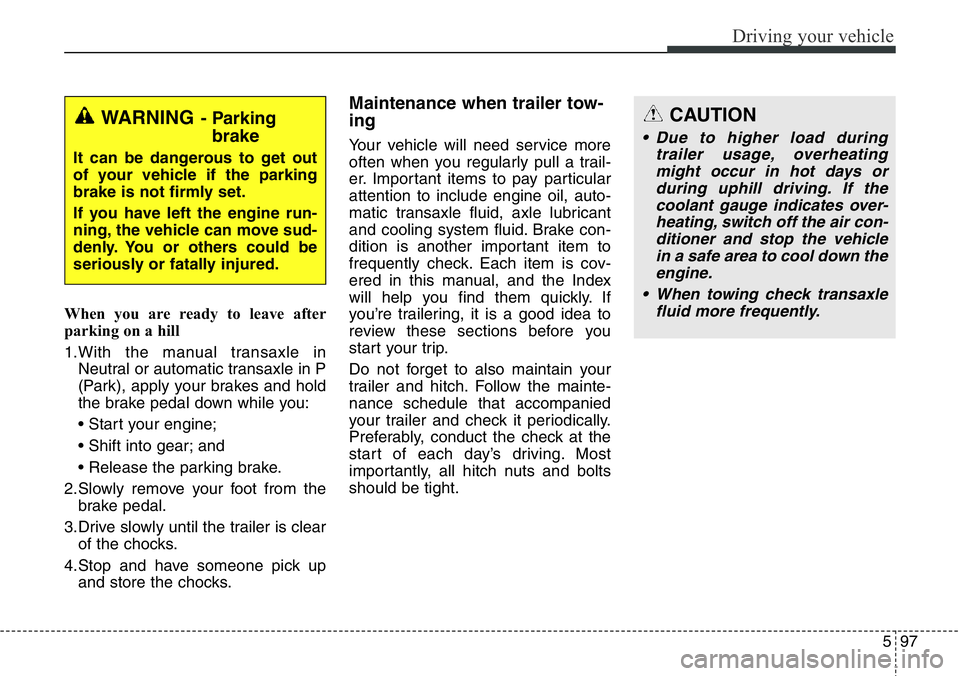
597
Driving your vehicle
When you are ready to leave after
parking on a hill
1.With the manual transaxle in
Neutral or automatic transaxle in P
(Park), apply your brakes and hold
the brake pedal down while you:
• Start your engine;
• Shift into gear; and
• Release the parking brake.
2.Slowly remove your foot from the
brake pedal.
3.Drive slowly until the trailer is clear
of the chocks.
4.Stop and have someone pick up
and store the chocks.
Maintenance when trailer tow-
ing
Your vehicle will need service more
often when you regularly pull a trail-
er. Important items to pay particular
attention to include engine oil, auto-
matic transaxle fluid, axle lubricant
and cooling system fluid. Brake con-
dition is another important item to
frequently check. Each item is cov-
ered in this manual, and the Index
will help you find them quickly. If
you’re trailering, it is a good idea to
review these sections before you
start your trip.
Do not forget to also maintain your
trailer and hitch. Follow the mainte-
nance schedule that accompanied
your trailer and check it periodically.
Preferably, conduct the check at the
start of each day’s driving. Most
importantly, all hitch nuts and bolts
should be tight.
CAUTION
• Due to higher load during
trailer usage, overheating
might occur in hot days or
during uphill driving. If the
coolant gauge indicates over-
heating, switch off the air con-
ditioner and stop the vehicle
in a safe area to cool down the
engine.
• When towing check transaxle
fluid more frequently.
WARNING- Parking
brake
It can be dangerous to get out
of your vehicle if the parking
brake is not firmly set.
If you have left the engine run-
ning, the vehicle can move sud-
denly. You or others could be
seriously or fatally injured.
Page 557 of 711
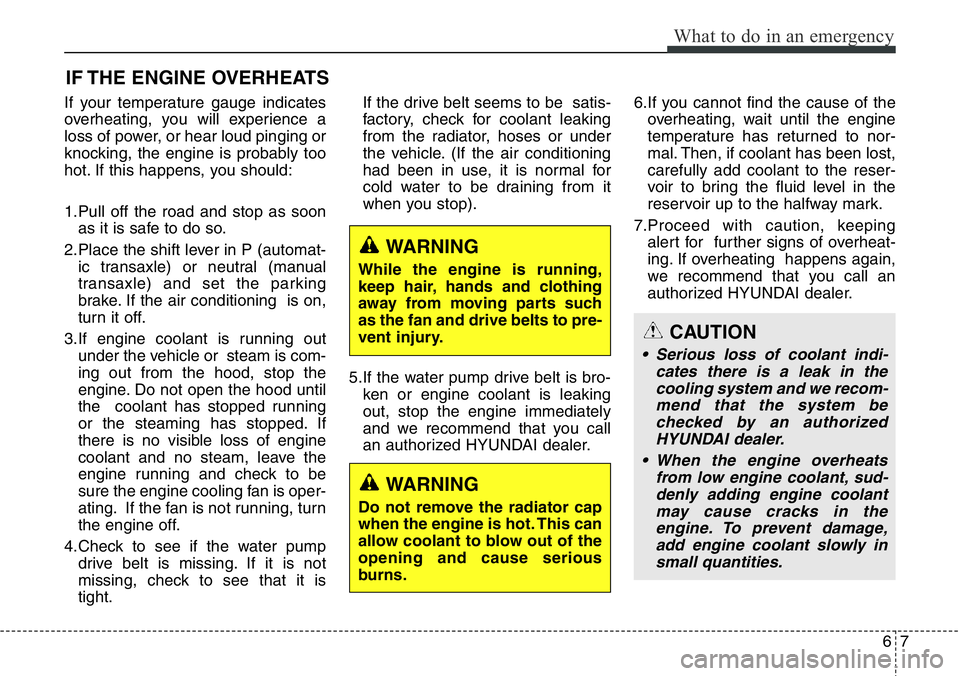
67
What to do in an emergency
IF THE ENGINE OVERHEATS
If your temperature gauge indicates
overheating, you will experience a
loss of power, or hear loud pinging or
knocking, the engine is probably too
hot. If this happens, you should:
1.Pull off the road and stop as soon
as it is safe to do so.
2.Place the shift lever in P (automat-
ic transaxle) or neutral (manual
transaxle) and set the parking
brake. If the air conditioning is on,
turn it off.
3.If engine coolant is running out
under the vehicle or steam is com-
ing out from the hood, stop the
engine. Do not open the hood until
the coolant has stopped running
or the steaming has stopped. If
there is no visible loss of engine
coolant and no steam, leave the
engine running and check to be
sure the engine cooling fan is oper-
ating. If the fan is not running, turn
the engine off.
4.Check to see if the water pump
drive belt is missing. If it is not
missing, check to see that it is
tight.If the drive belt seems to be satis-
factory, check for coolant leaking
from the radiator, hoses or under
the vehicle. (If the air conditioning
had been in use, it is normal for
cold water to be draining from it
when you stop).
5.If the water pump drive belt is bro-
ken or engine coolant is leaking
out, stop the engine immediately
and we recommend that you call
an authorized HYUNDAI dealer.6.If you cannot find the cause of the
overheating, wait until the engine
temperature has returned to nor-
mal. Then, if coolant has been lost,
carefully add coolant to the reser-
voir to bring the fluid level in the
reservoir up to the halfway mark.
7.Proceed with caution, keeping
alert for further signs of overheat-
ing. If overheating happens again,
we recommend that you call an
authorized HYUNDAI dealer.
WARNING
While the engine is running,
keep hair, hands and clothing
away from moving parts such
as the fan and drive belts to pre-
vent injury.
WARNING
Do not remove the radiator cap
when the engine is hot. This can
allow coolant to blow out of the
opening and cause serious
burns.
CAUTION
• Serious loss of coolant indi-
cates there is a leak in the
cooling system and we recom-
mend that the system be
checked by an authorized
HYUNDAI dealer.
• When the engine overheats
from low engine coolant, sud-
denly adding engine coolant
may cause cracks in the
engine. To prevent damage,
add engine coolant slowly in
small quantities.
Page 584 of 711
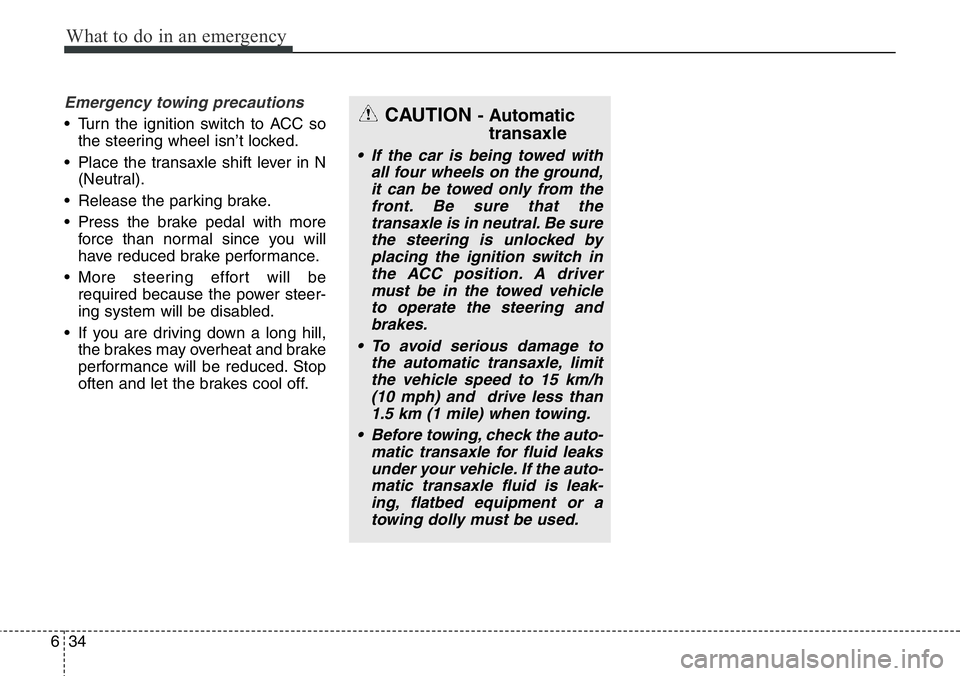
What to do in an emergency
34 6
Emergency towing precautions
• Turn the ignition switch to ACC so
the steering wheel isn’t locked.
• Place the transaxle shift lever in N
(Neutral).
• Release the parking brake.
• Press the brake pedal with more
force than normal since you will
have reduced brake performance.
• More steering effort will be
required because the power steer-
ing system will be disabled.
• If you are driving down a long hill,
the brakes may overheat and brake
performance will be reduced. Stop
often and let the brakes cool off.CAUTION - Automatic
transaxle
• If the car is being towed with
all four wheels on the ground,
it can be towed only from the
front. Be sure that the
transaxle is in neutral. Be sure
the steering is unlocked by
placing the ignition switch in
the ACC position. A driver
must be in the towed vehicle
to operate the steering and
brakes.
• To avoid serious damage to
the automatic transaxle, limit
the vehicle speed to 15 km/h
(10 mph) and drive less than
1.5 km (1 mile) when towing.
• Before towing, check the auto-
matic transaxle for fluid leaks
under your vehicle. If the auto-
matic transaxle fluid is leak-
ing, flatbed equipment or a
towing dolly must be used.
Page 586 of 711
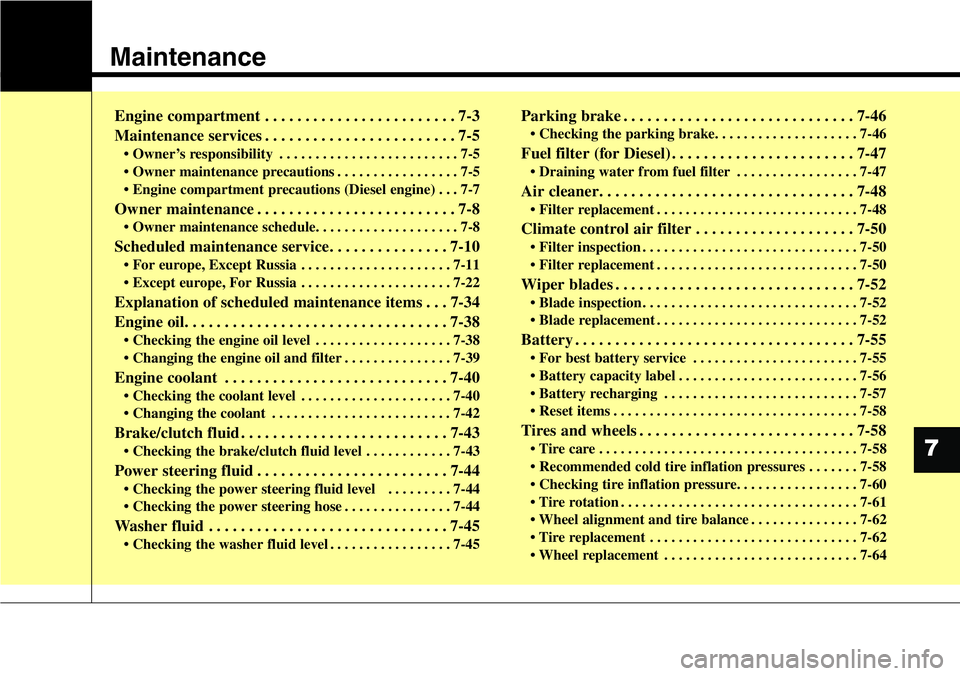
Maintenance
7
Engine compartment . . . . . . . . . . . . . . . . . . . . . . . . 7-3
Maintenance services . . . . . . . . . . . . . . . . . . . . . . . . 7-5
• Owner’s responsibility . . . . . . . . . . . . . . . . . . . . . . . . . 7-5
• Owner maintenance precautions . . . . . . . . . . . . . . . . . 7-5
• Engine compartment precautions (Diesel engine) . . . 7-7
Owner maintenance . . . . . . . . . . . . . . . . . . . . . . . . . 7-8
• Owner maintenance schedule. . . . . . . . . . . . . . . . . . . . 7-8
Scheduled maintenance service. . . . . . . . . . . . . . . 7-10
• For europe, Except Russia . . . . . . . . . . . . . . . . . . . . . 7-11
• Except europe, For Russia . . . . . . . . . . . . . . . . . . . . . 7-22
Explanation of scheduled maintenance items . . . 7-34
Engine oil. . . . . . . . . . . . . . . . . . . . . . . . . . . . . . . . . 7-38
• Checking the engine oil level . . . . . . . . . . . . . . . . . . . 7-38
• Changing the engine oil and filter . . . . . . . . . . . . . . . 7-39
Engine coolant . . . . . . . . . . . . . . . . . . . . . . . . . . . . 7-40
• Checking the coolant level . . . . . . . . . . . . . . . . . . . . . 7-40
• Changing the coolant . . . . . . . . . . . . . . . . . . . . . . . . . 7-42
Brake/clutch fluid . . . . . . . . . . . . . . . . . . . . . . . . . . 7-43
• Checking the brake/clutch fluid level . . . . . . . . . . . . 7-43
Power steering fluid . . . . . . . . . . . . . . . . . . . . . . . . 7-44
• Checking the power steering fluid level . . . . . . . . . 7-44
• Checking the power steering hose . . . . . . . . . . . . . . . 7-44
Washer fluid . . . . . . . . . . . . . . . . . . . . . . . . . . . . . . 7-45
• Checking the washer fluid level . . . . . . . . . . . . . . . . . 7-45
Parking brake . . . . . . . . . . . . . . . . . . . . . . . . . . . . . 7-46
• Checking the parking brake. . . . . . . . . . . . . . . . . . . . 7-46
Fuel filter (for Diesel) . . . . . . . . . . . . . . . . . . . . . . . 7-47
• Draining water from fuel filter . . . . . . . . . . . . . . . . . 7-47
Air cleaner. . . . . . . . . . . . . . . . . . . . . . . . . . . . . . . . 7-48
• Filter replacement . . . . . . . . . . . . . . . . . . . . . . . . . . . . 7-48
Climate control air filter . . . . . . . . . . . . . . . . . . . . 7-50
• Filter inspection . . . . . . . . . . . . . . . . . . . . . . . . . . . . . . 7-50
• Filter replacement . . . . . . . . . . . . . . . . . . . . . . . . . . . . 7-50
Wiper blades . . . . . . . . . . . . . . . . . . . . . . . . . . . . . . 7-52
• Blade inspection . . . . . . . . . . . . . . . . . . . . . . . . . . . . . . 7-52
• Blade replacement . . . . . . . . . . . . . . . . . . . . . . . . . . . . 7-52
Battery . . . . . . . . . . . . . . . . . . . . . . . . . . . . . . . . . . . 7-55
• For best battery service . . . . . . . . . . . . . . . . . . . . . . . 7-55
• Battery capacity label . . . . . . . . . . . . . . . . . . . . . . . . . 7-56
• Battery recharging . . . . . . . . . . . . . . . . . . . . . . . . . . . 7-57
• Reset items . . . . . . . . . . . . . . . . . . . . . . . . . . . . . . . . . . 7-58
Tires and wheels . . . . . . . . . . . . . . . . . . . . . . . . . . . 7-58
• Tire care . . . . . . . . . . . . . . . . . . . . . . . . . . . . . . . . . . . . 7-58
• Recommended cold tire inflation pressures . . . . . . . 7-58
• Checking tire inflation pressure. . . . . . . . . . . . . . . . . 7-60
• Tire rotation . . . . . . . . . . . . . . . . . . . . . . . . . . . . . . . . . 7-61
• Wheel alignment and tire balance . . . . . . . . . . . . . . . 7-62
• Tire replacement . . . . . . . . . . . . . . . . . . . . . . . . . . . . . 7-62
• Wheel replacement . . . . . . . . . . . . . . . . . . . . . . . . . . . 7-64
Page 588 of 711
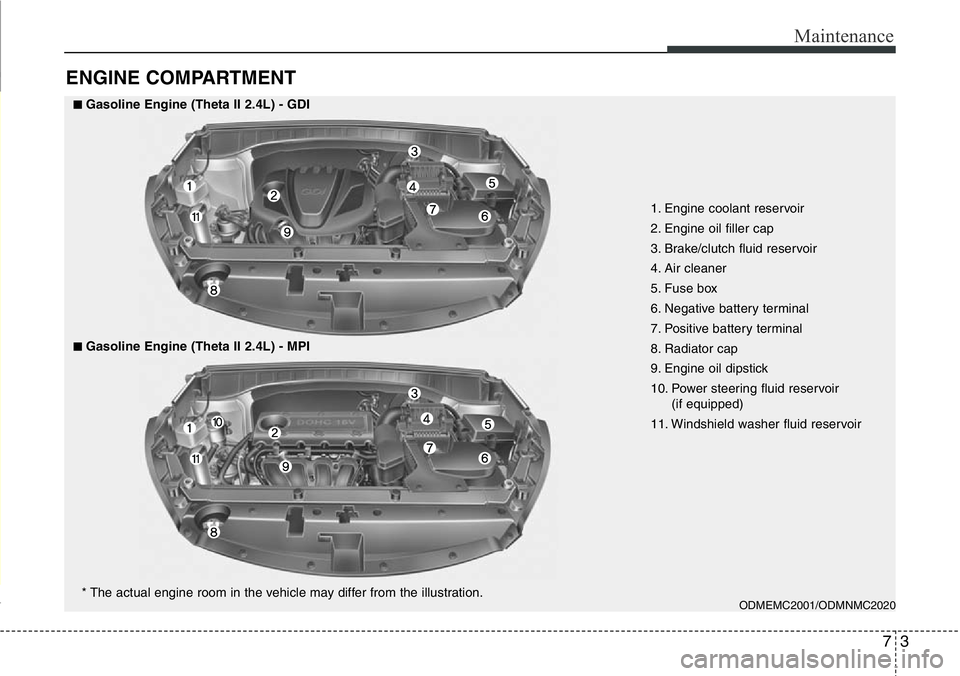
73
Maintenance
ENGINE COMPARTMENT
1. Engine coolant reservoir
2. Engine oil filler cap
3. Brake/clutch fluid reservoir
4. Air cleaner
5. Fuse box
6. Negative battery terminal
7. Positive battery terminal
8. Radiator cap
9. Engine oil dipstick
10. Power steering fluid reservoir
(if equipped)
11. Windshield washer fluid reservoir
ODMEMC2001/ODMNMC2020
■Gasoline Engine (Theta II 2.4L) - GDI
* The actual engine room in the vehicle may differ from the illustration.
■■Gasoline Engine (Theta II 2.4L) - MPI
Page 589 of 711
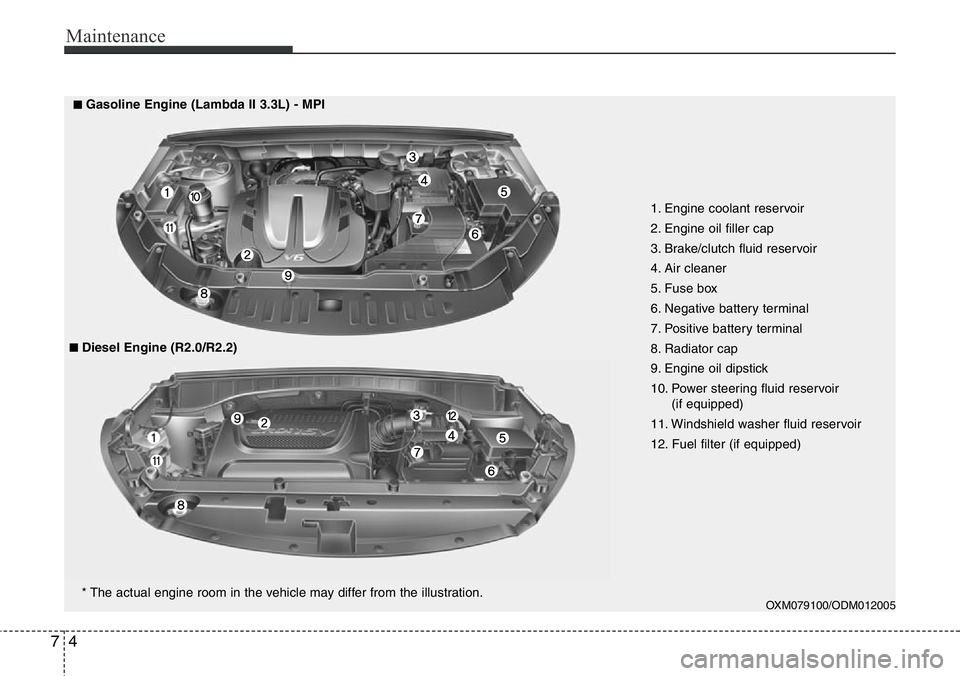
Maintenance
4 7
1. Engine coolant reservoir
2. Engine oil filler cap
3. Brake/clutch fluid reservoir
4. Air cleaner
5. Fuse box
6. Negative battery terminal
7. Positive battery terminal
8. Radiator cap
9. Engine oil dipstick
10. Power steering fluid reservoir
(if equipped)
11. Windshield washer fluid reservoir
12. Fuel filter (if equipped)
OXM079100/ODM012005
■Diesel Engine (R2.0/R2.2)
* The actual engine room in the vehicle may differ from the illustration.
■■Gasoline Engine (Lambda II 3.3L) - MPI
Page 593 of 711
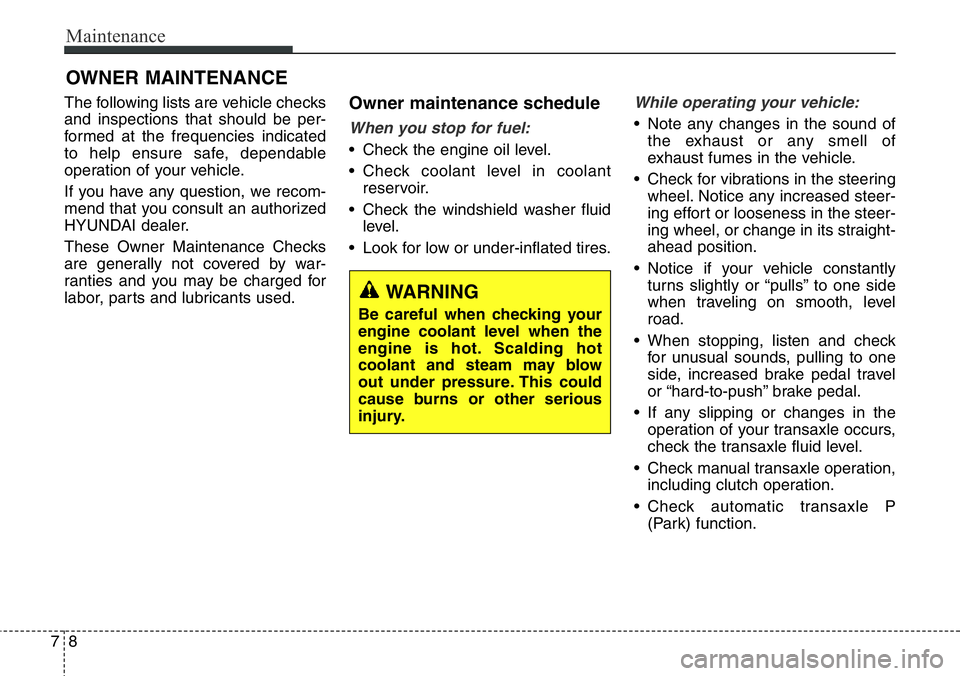
Maintenance
8 7
OWNER MAINTENANCE
The following lists are vehicle checks
and inspections that should be per-
formed at the frequencies indicated
to help ensure safe, dependable
operation of your vehicle.
If you have any question, we recom-
mend that you consult an authorized
HYUNDAI dealer.
These Owner Maintenance Checks
are generally not covered by war-
ranties and you may be charged for
labor, parts and lubricants used.Owner maintenance schedule
When you stop for fuel:
• Check the engine oil level.
• Check coolant level in coolant
reservoir.
• Check the windshield washer fluid
level.
• Look for low or under-inflated tires.
While operating your vehicle:
• Note any changes in the sound of
the exhaust or any smell of
exhaust fumes in the vehicle.
• Check for vibrations in the steering
wheel. Notice any increased steer-
ing effort or looseness in the steer-
ing wheel, or change in its straight-
ahead position.
• Notice if your vehicle constantly
turns slightly or “pulls” to one side
when traveling on smooth, level
road.
• When stopping, listen and check
for unusual sounds, pulling to one
side, increased brake pedal travel
or “hard-to-push” brake pedal.
• If any slipping or changes in the
operation of your transaxle occurs,
check the transaxle fluid level.
• Check manual transaxle operation,
including clutch operation.
• Check automatic transaxle P
(Park) function.
WARNING
Be careful when checking your
engine coolant level when the
engine is hot. Scalding hot
coolant and steam may blow
out under pressure. This could
cause burns or other serious
injury.